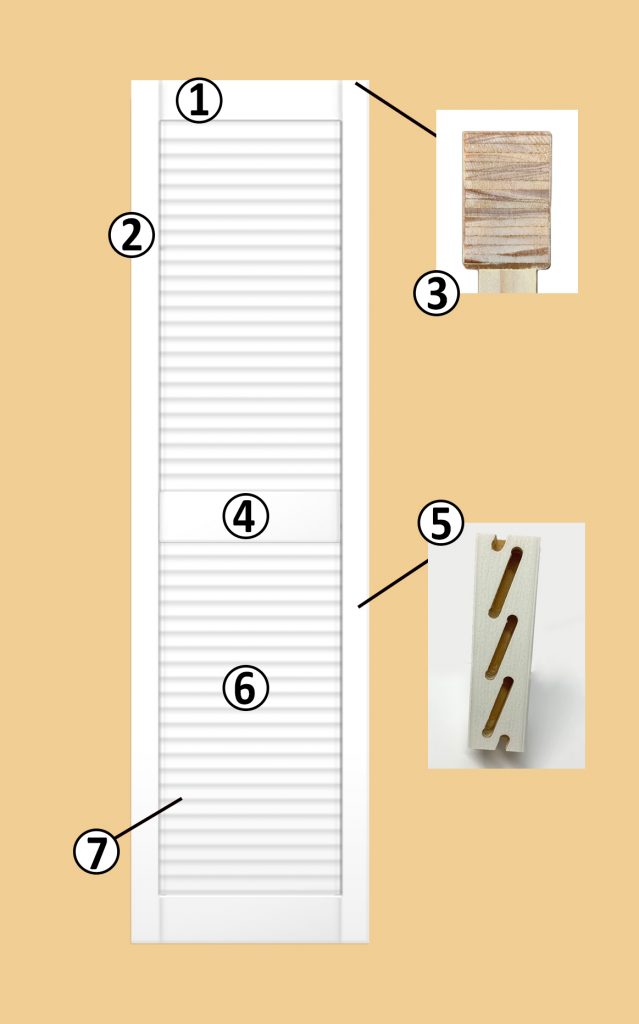

If you have ever purchased or considered purchasing an internal louvre door you may have come across some words or phrases that you have not heard of before. This can be confusing especially if it is your first time buying a louvre door. That’s where we can help. Take a look at our diagram detailing the anatomy of a louvre door which we hope will help give you some clarity.

When we talk about rails in louvre doors we are talking about the horizontal part of the frame of the door. There is a top rail and a bottom rail that form the frame of the door. However, the frame of a louvre door is not one continuous piece of wood instead the rails are joined via a butt joint to the stiles (which we will discuss next) usually with dowels. On some louvre doors the top rail tends to be shorter n height than the bottom rail. For example, a top rail could be 90mm in height whereas a bottom rail could be 95mm.
Stiles are the vertical parts of the louvre door and form the side parts of the frame. They are attached to the top and bottom rails that create the frame of the louvre door. Stiles are usually around 45mm in width although could be more than this on different variations of door. The stiles of a louvre door house each individual louvre blade to create the louvred effect. We discuss this in detail later on. Whilst older variations of louvre door have solid wood stiles shaped from a singular piece of timber (occasionally featuring a beaded edge), more modern variations have what we called engineered stiles (see point 3).
Engineered stiles are where the stile is built from layers of thin strips of wood as opposed to one piece of solid wood. In a process called laminating, individual thin strips of wood are bonded together with the wood grain facing in opposing directions. They’re then encased in a wood veneer which gives the appearance of solid wood. From the front you wouldn’t be able to tell the difference. In fact the only way to tell would be to look at the top of a stile. Engineered stiles are more advanced than solid wood as they strengthen the stile making the louvre less susceptible to bowing, splitting, or warping.
We have already established that the top and bottom parts of a louvre door are called rails. Whilst many louvre doors feature louvres from top to bottom, taller louvre doors require extra stability and so an additional bar is added to the door. Depending on the manufacturer this bar (or rail) is situated midway down the door or is also commonly positioned off centre. We refer to this as an offset horizontal bar.
In most louvre doors, the individual louvre blades are held in position by the stiles. This is done in the form of routing whereby small slat shaped holes are routed (cut out) of the stile in a synchronised row and then the louvre blades are slotted into position. Glue is not usually used in this process meaning that if singular louvre blades need to be replaced it is a fairly simple process.
In addition to the frame, louvre doors are primarily made up of louvre blades. Louvre blades (also referred to as slats) are thin, narrow pieces of wood that are slotted into place in the stiles in a horizontal position going from the top to the bottom of the door. The blades overlap each other in an angled position with a small gap left between each blade to achieve an ‘open louvre’ design. There are also louvre doors on the market that do not have a gap between each blade, these are referred to as ‘closed’ louvre doors. Depending on the style of the door louvre blades can also be placed vertically.
Louvre doors are available in various finishes, the most popular being natural, unpainted, and primed white. The clear, unpainted pine louvre doors are untreated and ready to be primed, stained, or varnished as per your requirements, A primed white louvre door has an applied base coat of paint making it ready for a topcoat to be applied. Usually when painting a louvre door, it is good practice to apply an undercoat so primed white louvre doors are good for those who want to save the task of applying an undercoat. Some louvre doors are factory painted white where the paint finish is so good sometimes a topcoat is not always required.
Click here to view our range of louvre doors.
